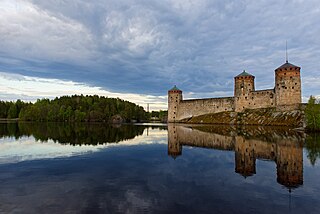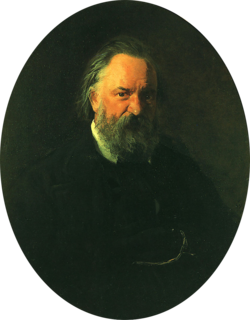Related Research Articles
This article contains information about the literary events and publications of 1555.

Richard Hakluyt was an English writer. He is known for promoting the English colonization of North America through his works, notably Divers Voyages Touching the Discoverie of America (1582) and The Principal Navigations, Voyages, Traffiques and Discoveries of the English Nation (1589–1600).

Olavinlinna is a 15th-century three-tower castle located in Savonlinna, Finland. It is built on an island in the Kyrönsalmi strait that connects the lakes Haukivesi and Pihlajavesi. It is the northernmost medieval stone fortress still standing. The castle forms a spectacular stage for the Savonlinna Opera Festival, held for the first time in the summer 1912.

Alexander Ivanovich Herzen was a Russian writer and thinker known as the "father of Russian socialism" and one of the main fathers of agrarian populism. With his writings, many composed while exiled in London, he attempted to influence the situation in Russia, contributing to a political climate that led to the emancipation of the serfs in 1861. He published the important social novel Who is to Blame? (1845–46). His autobiography, My Past and Thoughts, is often considered one of the best examples of that genre in Russian literature.

Constance Clara Garnett was an English translator of nineteenth-century Russian literature. She was the first English translator to render numerous volumes of Anton Chekhov's work into English and the first to translate almost all of Fyodor Dostoevsky's fiction into English. She also rendered works by Ivan Turgenev, Leo Tolstoy, Nikolai Gogol, Ivan Goncharov, Alexander Ostrovsky, and Alexander Herzen into English. Altogether, she translated 71 volumes of Russian literature, many of which are still in print today.

Norman Alexander MacCaig DLitt was a Scottish poet and teacher. His poetry, in modern English, is known for its humour, simplicity of language and great popularity.

The Fenni were an ancient people of northeastern Europe, first described by Cornelius Tacitus in Germania in AD 98.

Historia verdadera de la conquista de la Nueva España is a first-person narrative written in 1568 by military adventurer, conquistador, and colonist settler Bernal Díaz del Castillo (1492–1584), who served in three Mexican expeditions; those of Francisco Hernández de Córdoba (1517) to the Yucatán peninsula; the expedition of Juan de Grijalva (1518), and the expedition of Hernán Cortés (1519) in the Valley of Mexico; the history relates his participation in the fall of Emperor Moctezuma II, and the subsequent defeat of the Aztec Empire.

Carta marina et descriptio septentrionalium terrarum is the first map of the Nordic countries to give details and place names, created by Swedish ecclesiastic Olaus Magnus and initially published in 1539. Only two earlier maps of the Nordic countries are known, those of Jacob Ziegler and Claudius Clavus.

The Viking revival was a movement reflecting new interest in, and appreciation for Viking medieval history and culture. Interest was reawakened in the late 18th and 19th centuries, often with added heroic overtones typical of that Romantic era.

David Garnett was an English writer and publisher. As a child, he had a cloak made of rabbit skin and thus received the nickname "Bunny", by which he was known to friends and intimates all his life.
Olaus Magnus was a Swedish writer, cartographer, and Catholic ecclesiastic.
Germanic philology is the philological study of the Germanic languages, particularly from a comparative or historical perspective.

Gothicism or Gothism was a cultural movement in Sweden, centered on the belief in the glory of the Swedish Geats, who were identified with the Goths. The founders of the movement were Nicolaus Ragvaldi and the brothers Johannes and Olaus Magnus. The belief continued to hold power in the 17th century, when Sweden was a great power following the Thirty Years' War, but lost most of its sway in the 18th. It was renewed by the Viking revival and Romantic nationalism in the early 19th century, this time with the Vikings as heroic figures.

Historia de Gentibus Septentrionalibus was a monumental work by Olaus Magnus on the Nordic countries, printed in Rome 1555. It was a work which long remained for the rest of Europe the authority on Swedish matters. Its popularity increased by the numerous woodcuts of people and their customs, amazing the rest of Europe. It is still today a valuable repertory of much curious information in regard to Scandinavian customs and folklore.
John Fuller FRSL is an English poet and author, and Fellow Emeritus at Magdalen College, Oxford.

Hedwig Jagiellon was a granddaughter of Emperor Sigismund and of the Jagiellonian dynasty as daughter of Sigismund I the Old of Poland. She was Electress of Brandenburg by marriage to Joachim II Hector, Elector of Brandenburg.

The Madagascar serpent eagle is a species of bird of prey in the family Accipitridae. It is placed in the monotypic genus Eutriorchis. It is endemic to Madagascar. Its natural habitat is subtropical or tropical moist lowland forests. It is threatened by habitat loss.
The Hippopodes were a race of humanoids with horses' hooves mentioned in Greek mythology and Medieval bestiaries.

The kraken is a legendary sea monster of enormous size said to appear off the coasts of Norway.
References
- ↑ Adamson, Lynda G. (1999). World Historical Fiction: An Annotated Guide to Novels for Adults and Young Adults . Phoenix: Oryx Press. p. 146. ISBN 978-1-57356-066-5.
- ↑ Review by Mark Slonim in Slavic Review , Vol. 22, No. 2 (June 1963), pp. 374-375.
- ↑ "Alexander the great" by Philip Toynbee, The Observer, 7 Jul 1968, p. 26. ProQuest Historical Newspapers. Retrieved 22 September 2015.
- ↑ PUBLICATIONS OF THE HAKLUYT SOCIETY Second Series, Part II. Hakluyt Society. Retrieved 22 September 2015.
- ↑ "New Fiction", The Times , 20 April 1961, p. 15.